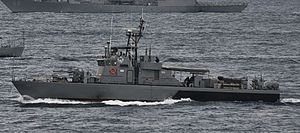
The Chamsuri class are patrol boats originally constructed for and operated by the Republic of Korea Navy. They first entered service in 1979, and they have since seen service with five other navies, of which the Philippine Navy is currently the largest import user. These boats were built by the Korea Tacoma, and Korea SB & Eng. Masan shipyards. In Korea, the Chamsuri-class boats are being retired and replaced by Gumdoksuri-class patrol vessels.

BRP Rajah Humabon (PS-11) was a former destroyer escort of the United States Navy and a former frigate of the Philippine Navy. She was the last World War II-era destroyer escort/frigate active in her fleet, and one of the oldest active warships in the world, until 15 March 2018 when she was formally decommissioned after 75 years. She was one of three ex-USN Cannon-class destroyer escorts that served the Philippine Navy, the others being BRP Datu Sikatuna (PF-5/PS-77) and BRP Datu Kalantiaw (PS-76).

BRP Rizal (PS-74) was the lead ship and first of two Rizal-class ships in service with the Philippine Navy. She was an ex-United States Navy Auk-class minesweeper that was produced during World War II, and was classified as a patrol corvette protecting the vast waters of the Philippines. Along with other ex-World War II veteran ships of the Philippine Navy, she was considered one of the oldest active fighting ships in the world, until 2020.
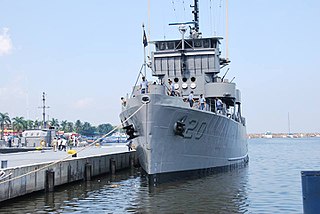
BRP Magat Salamat (PS-20) is one of several Miguel Malvar class of patrol corvettes in service with the Philippine Navy. She was originally built as USS Gayety (AM-239), an Admirable-class minesweeper with a similar hull to the PCE-842-class patrol craft produced during World War II. In 1962 she was transferred to South Vietnam for service in the Republic of Vietnam Navy as RVNS Chi Lang II (HQ-08). She was acquired by the Philippine Navy in April 1976 and later on commissioned as Magat Salamat. Along with other ex-World War II veteran ships of the Philippine Navy, she is considered one of the oldest active fighting ships in the world today.
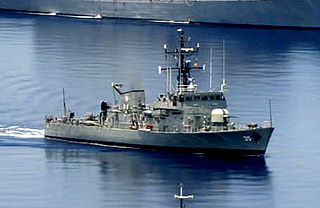
BRP Emilio Jacinto (PS-35) is the lead ship of the Jacinto-class corvettes currently assigned to the Offshore Combat Force of the Philippine Fleet. She is one of few ships in the Philippine Navy equipped with modern systems after the completion of combat, navigation and weapon systems upgrade of her class in August 2019. She was originally called HMS Peacock (P239) during her service with the Royal Navy.
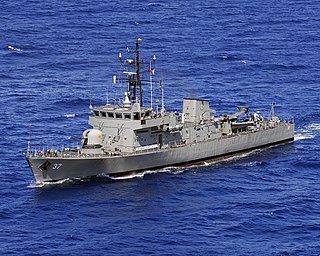
The Jacinto-class patrol vessels currently in service with the Philippine Navy are three ships formerly belonging to the Royal Navy's Hong Kong Squadron as Peacock-class corvettes until 1997. The ships have undergone combat, electronics, weapon, propulsion and hull upgrades, with the most recent upgrade completed in August 2019. These increased their capabilities compared to the original Peacock-class vessels.

BRP Miguel Malvar (PS-19) is the lead ship of the Malvar class of corvettes of the Philippine Navy. She was originally built as USS Brattleboro PCE(R)-852, a PCE(R)-848-class rescue patrol craft escort for the United States Navy during World War II. In 1966 she was transferred to South Vietnam for service in the Republic of Vietnam Navy as RVNS Ngọc Hồi (HQ-12). She was acquired by the Philippine Navy in April 1976 and later on commissioned as Miguel Malvar after Miguel Malvar y Carpio.

BRP Pangasinan (PS-31) was a Miguel Malvar-class corvette of the Philippine Navy. She was originally built as USS PCE-891, a PCE-842-class patrol craft for the United States Navy during World War II. She was decommissioned from the U.S. Navy and transferred to the Philippine Navy in July 1948 and renamed RPS Pangasinan (E-31).
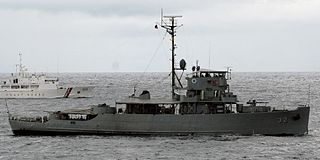
BRP Iloilo (PS-32) was a Miguel Malvar-class corvette of the Philippine Navy. She was originally built as USS PCE-897, a PCE-842-class patrol craft for the United States Navy during World War II. She was decommissioned from the U.S. Navy and transferred to the Philippine Navy in July 1948 and renamed RPS Iloilo (E-32) after the Philippine province of the same name. Along with other World War II-era ships of the Philippine Navy, Iloilo was considered one of the oldest active fighting ships in the world, being in continuous service for over seven decades.
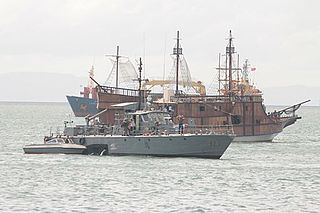
BRP Carlos Albert (PC-375) is the fifth ship of the Jose Andrada-class coastal patrol boats of the Philippine Navy. It is part of the first batch of its class ordered through US Foreign Military Sales (FMS) in 1990, and was commissioned with the Philippine Navy in January 1992. It was initially designated as Fast Patrol Craft, and was numbered "DF-375", but later on was re-designated as a Patrol Gunboat, and was re-numbered as "PG-375", until another round of reclassification changed its designation as a Patrol Craft with hull number "PC-375" from April 2016.

BRP Heracleo Alano (PC-376) is the sixth ship of the Jose Andrada-class coastal patrol boats of the Philippine Navy. It is part of the first batch of its class ordered through U.S. Foreign Military Sales (FMS) in 1990, and was commissioned with the Philippine Navy in January 1992. It was initially designated as Fast Patrol Craft, and was numbered "DF-376", but later on was re-designated as a Patrol Gunboat, and was finally re-numbered as "PG-376". Another round of reclassification was made in April 2016, which redesignated the patrol gunboat as the coastal patrol craft BRP Heracleo Alano (PC-376)
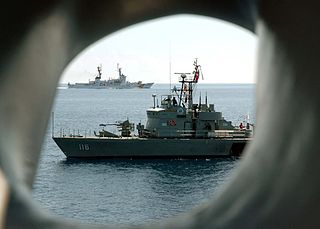
BRP Nicolas Mahusay (PC-119) was a Tomas Batilo-class fast attack craft of the Philippine Navy. It was transferred by the South Korean government in 1998. It was initially acquired as a spare parts hulk, but the need for additional ships led to its commissioning with the Philippine Navy on 2 July 1998.

BRP Dionisio Ojeda (PC-117) was a Tomas Batilo-class fast attack craft of the Philippine Navy. It was part of the second batch transferred by the South Korean government in 2006. It was formally commissioned with the Philippine Navy in 2007.
BRP Emilio Liwanag (PC-118) was a Tomas Batilo class fast attack craft of the Philippine Navy. It was part of the last batch of such craft transferred to the Philippines by the South Korean government in 2006. After 2 years of refurbishing, refitting and upgrade, the ship was commissioned into active service by the Philippine Navy on 15 April 2011, although it was presented to the public as early as May 2010 during the 112th Anniversary of the Philippine Navy.
BRP Bonny Serrano (PC-111) was a Tomas Batilo-class fast attack craft of the Philippine Navy. It is part of the first batch transferred by the South Korean government on 15 June 1995, and arrived in the Philippines in August 1995. It was commissioned with the Philippine Navy on 22 May 1996,
BRP Bienvenido Salting (PG-112) was a Tomas Batillo class fast attack craft of the Philippine Navy. Under the RPROK Defense Agreement, it was part of the first five PKM ships transferred by the South Korean government on 15 June 1995. It arrived in the Philippines in August 1995 and was commissioned with the Philippine Navy on 22 May 1996.
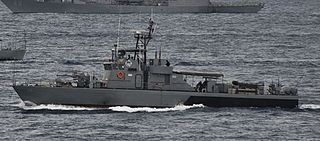
The Tomas Batilo class was a ship class of eight patrol boats that were previously service of the Philippine Navy. These ships were formerly used by the South Korean Navy as Chamsuri/Wildcat class fast attack crafts. All eight ships have been retired from active service, with two units lost in separate incidents while the rest are in different state of disposal.

BRP Filipino Flojo (PC-386) is the fifteenth ship of the Jose Andrada-class patrol craft coastal patrol craft of the Philippine Navy. It is part of the second batch of its class ordered through US Foreign Military Sales (FMS) in 1993, and was commissioned with the Philippine Navy on 22 May 1996. She is currently in active service with the Littoral Combat Force, Philippine Fleet.

BRP Gregorio del Pilar (PS-15) is the lead ship of her class of offshore patrol vessel of the Philippine Navy. She is the second ship to be named after Gregorio del Pilar, a Filipino revolutionary general known for his role at the Battle of Tirad Pass. She was originally designated as "PF-15" from 2012 to mid-2016. Then the Navy adopted a new code designation system and she was redesignated as "FF-15". In February 2019, the Navy downgraded the status of the entire class from frigate to patrol ship and redesignated her to "PS-15".
BRP Anastacio Cacayorin (PC-387) is the sixteenth ship of the Jose Andrada-class patrol craft coastal patrol craft of the Philippine Navy. She was commissioned in 1996 and is currently in active service with the Littoral Combat Force, Philippine Fleet.
